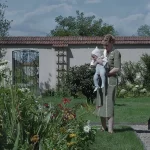Reference Material, by David Bax
When a film is set in the past, there’s usually a pretty good reason. Often the time period is clearly important to the story, like in last year’s Not Fade Away. Or perhaps the stricter mores of the past are necessary to achieve the proper tension like in, oh, let’s say, The Widow of Saint-Pierre. Maggie Carey’s The To Do List invites raised eyebrows by being set in the summer of 1993. Does Carey have a good reason for placing the action twenty years in the past or is it just an excuse to make jokes at the expense of things that used to be popular but seem stupid now?
Aubrey Plaza plays Brandy, the valedictorian of the class of 1993 at her Boise public high school. A textbook Type A personality (is there any other kind?), Brandy aims to be the best at everything she does. So after an accidental kiss at a graduation party and a frank discussion with her sister (Rachel Bilson), the virginal Brandy endeavors to approach sex with the same calculated and exhaustive veracity as she does everything else. So she makes the titular list and starts checking off items with the help of the various boys in her social circle.
Those boys and the rest of the people in the film are played by a very impressive cast of comedic talent. Joining Plaza and Bilson are Scott Pilgrim’s Johnny Simmons, Scott Porter, Donald Glover, Christopher Mintz-Plasse, Andy Samberg, Modern Family’s Nolan Gould, Adam Pally, Jack McBrayer, Dominic Dierkes and D.C. Pierson, all of whom are a joy. The standouts, though, include Alia Shawkat and Sarah Steele as Brandy’s more sexually experienced best friends, each individual characters in their own rights and not in any way cheapened or demeaned by their relative promiscuity; Connie Britton and Clark Gregg as, respectively, Brandy’s somewhat morally progressive mother and old-fashioned but genuinely caring father; and Bill Hader as Brandy’s boss at the local pool, who wields most of the best lines.
Carey’s best justifications for setting the film when she does – and the best stuff the film has going for it, period – are present in the form of discussions, both overt and subtle, about feminism. Brandy is in many ways representative of the movement at the time. Her emphasis on the importance of sex and the tacit admission that women and men may have natural born differences other than physical ones place her within the worldview of feminism’s third wave. This is apparent in her preference for dumb beefcakes like Porter’s lifeguard over sensitive pushovers like Simmons’ Duckie-like puppy dog. Perhaps that can be attributed to her age but it should also serve as a lesson to young men who whine that “nice guys finish last” without realizing that their idea of niceness is really just simpering and pitiful. Brandy also lionizes the influence and achievement of Hilary Clinton. Also, she reaches her first orgasm while face to face with a photograph of the then first lady, a tribute any public figure should be proud to receive. Also referenced repeatedly is Gloria Steinem, who would have recently spearheaded the revival of Ms. magazine and made a woman’s right to choose her chief issue. Really, that’s what Brandy is embodying. Her particular choice may not involve abortion (though she dons a “Pro-Choice, Pro-Clinton” t-shirt at bedtime) but she is nevertheless insisting on her own agency in regards to her body.
It’s a message that’s unfortunately resonant twenty years later, where the girls of Spring Breakers treat their bodies as commodities, employing them in the same superficial way they do minority culture or violence. What’s not resonant twenty years later, however, is Hypercolor shirts. And Saved by the Bell. And jeans with holes and all the other countless things Carey references nonstop. That’s not much of an exaggeration. The namechekcing of early 90s things and people, from VHS to Dr. Ian Malcolm, almost does not stop. By the time Bilson implores Plaza to hurry up so she doesn’t miss Home Improvement, the conceit has practically collapsed in on itself. And that’s only about halfway through.
I was told that the version of the film I saw was not complete. This was said to only concern issues of music and effects but perhaps the filmmakers will have taken the time to tone down the egregious references (as well as cut out a scene that pays homage to Caddyshack’s candy bar in the pool and that should be no thinking person’s idea of comedy). As it stands, The To Do List contains within it a smart comedy that adeptly comments on our recent past but is buried under a mountain of neon-colored nonsense.






























